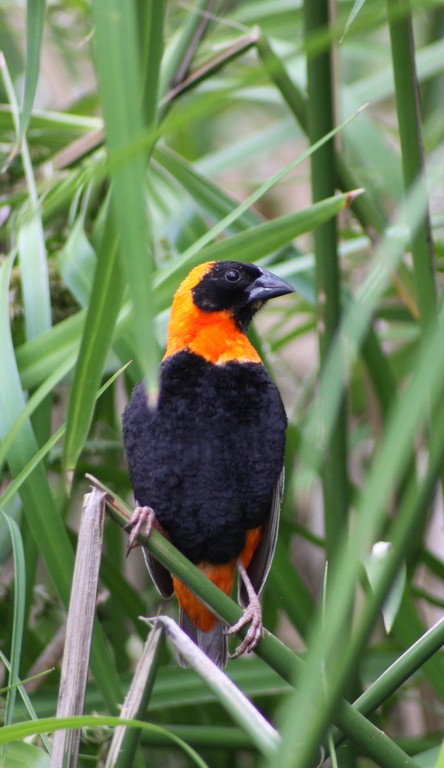Southern Red Bishop
A species of Bishops and widowbirds, Also known as Red Bishop Bird Scientific name : Euplectes orix Genus : Bishops and widowbirds
Southern Red Bishop, A species of Bishops and widowbirds
Also known as:
Red Bishop Bird
Botanical name: Euplectes orix
Genus: Bishops and widowbirds
Content
Description People often ask General Info
 Photo By derekkeats , used under CC-BY-SA-2.0 /Cropped and compressed from original
Photo By derekkeats , used under CC-BY-SA-2.0 /Cropped and compressed from original Description
It is 10–11 centimetres long and has a thick conical bill. Breeding males are brightly coloured with red (occasionally orange) and black plumage. The forehead, face and throat are black and the rest of the head is red. The upperparts are red apart from the brown wings and tail. The upper breast and under tail-coverts are red while the lower breast and belly are black. The non-breeding male and female have streaky brown plumage, paler below. Females are smaller than the males. It has various twittering calls and a nasal contact call. The male has a buzzing song. Breeding males of the northern red bishop have a red throat, black extending further back on the crown and long tail-coverts which almost cover the tail. The females and non-breeding males are almost identical to those of the southern red bishop. 
Size
13 cm
Life Expectancy
5 years
Nest Placement
Shrub
Feeding Habits
Southern Red Bishop's diet consists mainly of seeds and arthropods, including insects like beetles, dragonflies, and caterpillars. It actively forages, often hunting for flies, termites, and small crustaceans, displaying a preference for kelp flies and larvae. Southern Red Bishop exhibits specialized feeding adaptations for a varied diet.
Habitat
Southern Red Bishop predominantly inhabits tall grasslands and cultivated fields in open country, often in close proximity to freshwater sources such as wetlands, reeds, and sedges. These regions typically range from lowland areas at sea level to elevations up to 1700 meters. During the breeding season, southern Red Bishop preferentially resides near water bodies, within lush vegetation, including crops like sugar cane. In contrast, outside the breeding season, southern Red Bishop can adapt to drier environments, extending into savannas and non-aquatic grasslands.
Dite type
Granivorous
General Info
Feeding Habits
Bird food type
Behavior
It is a fairly gregarious bird, nesting in colonies and foraging in flocks. It feeds on seeds and some insects. It often roosts in mixed flocks with other members of the weaver family. At the start of the breeding season, the males build several nests to attract females. They perform a display flight with their feathers fluffed up. They are polygynous and mate with several females. The nest is most commonly built among reeds and is made of grasses and other plant materials woven together. Two to four eggs are laid. 
Distribution Area
It occurs from South Africa north to Angola, southern and eastern parts of the Democratic Republic of Congo,northern Zambia southern Uganda north-east Nigeria and south-west Kenya. It is largely absent from the Namib Desert and Kalahari. In the breeding season it is found near water among grass, reeds, sedges or crops such as sugar cane. Outside the breeding season it will venture into drier grassland and savanna habitats. 
Species Status
Not globally threatened.
Scientific Classification
Phylum
Chordates Class
Birds Order
Perching birds Family
Weavers Genus
Bishops and widowbirds Species
Southern Red Bishop